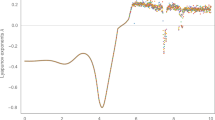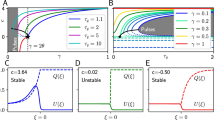Abstract
We investigate the signal propagation process in a chain of series-connected asynchronous threshold elements. The asynchronous nature of the elements is manifested in the fact that they can have varying duration of switching from a passive state to an active state and vice versa. The elements are reactive; i.e., they are excited as a result of external influences and become passive when there are no external influences. It is shown that, depending on the element on-off switching transient duration ratio, the duration of the signal passing through the chain can be preserved, increase, or decrease. In the last case, the signal does not pass through a sufficiently long chain. The conditions for the passage of a signal through the chain are stated.

Similar content being viewed by others
Notes
The papers [1, 2] deal with multisorted broadcast communications—a signal of a particular sort is perceived by all elements that have inputs sensitive to that sort. In the present paper, all signals are ordinary single-sorted signals, and the connections are local, i.e., connect exactly two elements each.
In Fig. 1, already the output signal \( N_1 \) is short for \( N_2 \).
REFERENCES
Kuznetsov, O.P., Bazenkov, N.I., Boldyshev, B.A., et al., Asynchronous discrete model of chemical interactions in simple neural systems, Sci. Tech. Inf. Process., 2018, vol. 45, no. 6, pp. 375–389.
Kuznetsov, O.P., Asynchronous multi-agent multisorted systems, Autom. Remote Control, 2021, vol. 82, no. 2, pp. 294–307.
Brzozowski, J.A., Topics in asynchronous circuit theory, Recent Adv. Formal Lang. Appl., 2006, vol. 25, pp. 11–42.
Sparsø, J., Introduction to Asynchronous Circuit Design, TU Denmark, 2020.
Chandy, K.M., Event-Driven Applications: Costs, Benefits and Design Approaches, California Inst. Technol., 2006.
Davies Alex, Async in C# 5.0, O’Reilly, 2012.
Buzsáki, G., Neural syntax: cell assemblies, synapsembles, and readers, Neuron, 2010, vol. 68, no. 3, pp. 362–385.
Feinerman, O., Segal, M., and Moses, E., Signal propagation along unidimensional neuronal networks, J. Neurophysiol., 2005, vol. 94, no. 5, pp. 3406–3416.
D’Haene, M., Schrauwen, B., Van Campenhout, J., and Stroobandt, D., Accelerating event-driven simulation of spiking neurons with multiple synaptic time constants, Neural Comput., 2008, vol. 21, pp. 1068–1099.
Naveros, F., Garrido, J.A., Carrillo, R.R., Ros, E., and Luque, N.R., Eventand time-driven techniques using parallel CPU–GPU co-processing for spiking neural networks, Front. Neuroinf., 2017, vol. 11. article ID 7, pp. 1–22.
Pecevski, D., Kappeland, D., and Jonke, Z., Nevesim: event-driven neural simulation framework with a Python interface, Front. Neuroinf., 2014, vol. 8, p. 70.
Kuznetsov, O.P., Signal spreading through a chain of asynchronous threshold elements, Lecture Notes in Networks and Systems. Proc. Fifth Int. Sci. Conf. “Intelligent Information Technologies for Industry” (IITI’21), 2021, vol. 330, pp. 24–34.
Nicholls, J.G, Martin, A.R., Wallace, B.G., and Fuchs, P.A., From Neuron to Brain, Sunderland, MA: Sinauer Assoc., 2001. Translated under the title: Ot neirona k mozgu, Moscow: URSS–Lenand, 2019.
Jackson, M.O., Social and Economic Networks, Princeton: Princeton Univ. Press, 2008.
Kempe, D., Kleinberg, J., and Tardos, E., Maximizing the spread of influence through a social network, Theory Comput., 2015, vol. 11, no. 4, pp. 105–147.
Schelling, T., Dynamic models of segregation, J. Math. Sociol., 1971, vol. 1, pp. 143–186.
Granovetter, M.S., Threshold models of collective behavior, Am. J. Sociol., 1978, vol. 83, no. 6, pp. 1420–1443.
Li, Z. and Tang, X., A study of collective action threshold model based on utility and psychological theories, in Lecture Notes in Computer Science, 2012, vol. 7669, pp. 474–482.
Breer, V.V., Models of tolerant threshold behavior (from T. Schelling to M. Granovetter), Probl. Upr., 2016, no. 1, pp. 11–20.
Zhilyakova, L. and Gubanov, D., Double-threshold model of the activity spreading in a social network: the case of two types of opposite activities, Proc. 11th IEEE Int. Conf. Appl. Inf. Commun. Technol. AICT2017, 2017, vol. 2, pp. 267–270.
Funding
This work was financially supported in part by the Russian Foundation for Basic Research, project no. 20-07-00190.
Author information
Authors and Affiliations
Corresponding author
Additional information
Translated by V. Potapchouck
Rights and permissions
About this article
Cite this article
Kuznetsov, O.P. On the Conditions for the Passage of a Signal Through a Chain of Asynchronous Threshold Elements. Autom Remote Control 83, 919–934 (2022). https://doi.org/10.1134/S0005117922060091
Received:
Revised:
Accepted:
Published:
Issue Date:
DOI: https://doi.org/10.1134/S0005117922060091




